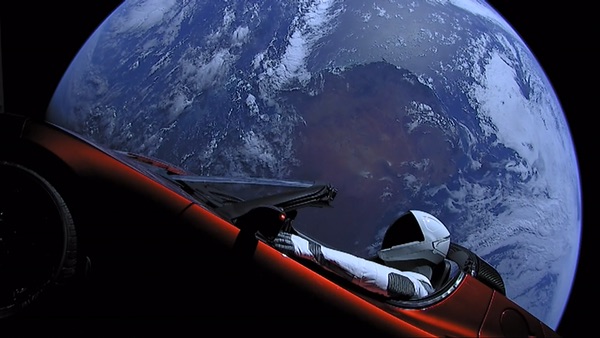Man to mannequin: is this progress?by Ajey Lele
|
| Sending a mannequin in a spacesuit to deep space has captured the world's imagination, when nearly half a century ago humans had been to the Moon. |
A few days before this launch, on February 3, another launch took place which largely has gone unnoticed. This was a launch conducted by Japan of a modified SS-520 sounding rocket. This launch is also unique in its own way, being the smallest rocket ever to place a satellite into orbit. The payload placed in orbit is a three-unit cubesat with a mass of just three kilograms.
Lately, SpaceX has demonstrated what tremendous achievements a private entity can do in a very short span of time. The company’s CEO, Elon Musk, and his team deservers all the credit for their vision, ambition, and will to succeed. Implementation of novel ideas has been the key for the success of SpaceX. Today, SpaceX is offering cost-effective options for conducting various activities in outer space. They are not only dreaming big, but also successfully converting these dreams into realities. It’s heartening to see that, at present, one individual is almost singlehandedly spearheading the future of human ambitions in space, and he deserves all the kudos for that.
However, it is also important to raise one issue at more at a philosophical level. This is not intended to lessen the success of Falcon Heavy. Nevertheless, it is important to compare and contrast the achievements of this mission with what the humans have achieved in the past and try to understand the possible reasons for the regression of the human community in the space domain for all these years. Sending a mannequin in a spacesuit to deep space has captured the world's imagination, when nearly half a century ago humans had been to the Moon. How (and why) humanity faltered for all these years that, today, Elon Musk has been forced to reinvent the wheel. So, having a mannequin in a car orbiting in the solar system is more about previous generations failing the likes of Musk than his own success.
Neil Armstrong and Buzz Aldrin landed on the Moon on July 20, 1969, and also successfully returned to Earth. The last human mission to Moon, Apollo 17, landed there on December 11, 1972. Given this backdrop, it is actually a slap on the face of human ingenuity to celebrate the sending of a mannequin “driving a car” in deep space. Why the world did collectively falter for all these decades? Technically, NASA and the US leadership could be blamed for not continuing with the human Moon program. But, at the same time is also a reality that no other country in the world took the inspiration from the success of the Apollo mission (perhaps the former USSR gave up too early) or dared to go that far where the likes of Neil Armstrong had gone.
| Given this backdrop, it is actually a slap on the face of human ingenuity to celebrate the sending of a mannequin “driving a car” in deep space. Why the world did collectively falter for all these decades? |
During the Cold War era, people went to Moon not merely for the love of the Moon, but more to demonstrate national technological superiority. Then, NASA's budget was around five percent of the federal budget. Now, it is less than 0.5 percent. After all these years, money continues to remain the major factor for every nation. During the last four decades, nobody dared to have planned human missions in deep space mainly because nations understood that such programs are unaffordable. In addition, technology was definitely an issue. Some democracies faced opposition from citizens who questioned the logic of large financial investments for human space exploration. Possibly, it was also the failure of the political and scientific leadership, who weren’t able to find a way through the maze of the challenges.
It appears that the next steps after the human visits to the Moon were also not clearly identified and stated. In reality, humanity was unsure about what to do after reaching the Moon. For many years there has been much talk of human settlements on other planet, yet not much technological progress has happened in that direction. Today, with the advantage of hindsight, it could be argued that, after demonstrating the capability of sending humans to the Moon, NASA could have started a robotic program towards establishing settlements on the Moon. By today they might have been in the position to have human settlements on the Moon.
It is sad that Elon Musk was forced to reinvent the wheel. His success is a combination of many factors, including a fascination for space, scientific acumen, frugal engineering, innovation, imagination, and his adventurous attitude. Primarily, five decades ago it was the Cold War that required the scientists to think big and reach the Moon, but today it is business that is forcing humans to reach the stars. This movement should not be allowed to fizzle out.
